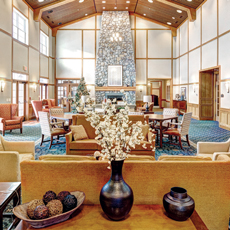
Shaker Pointe at Carondelet in Watervliet, NY, has a design scheme that owes everything to a religious society that had a strong presence in the upstate area during the 19th century. With a three-phase construction sequence that took eight years and $54 million to complete, The Society of the Sisters of St. Joseph envisioned a comprehensive senior living facility for the local community that would reflect the Shaker heritage while providing a safe, comfortable environment for residents.
“When we began in 2007, there was a surge of seniors in the area, so we did a tremendous amount of planning with the neighborhood and town,” says Sister Kay Ryan, who serves on the executive team with Sister Lauren
VanDermark. “Everybody was looking at the needs of the area and how we could meet those needs. We envisioned that this would be a great middle income housing community with amenities and services.”
The economic collapse of 2008 threatened to put the project on hold, but the team put together an incremental construction plan that kept Shaker Pointe on course.
“Our original finance plan was always intended to be a $50-$55 million project and after the meltdown, we carved it off and got financing for each phase,” Ryan says. “Financing was a combination of regular construction loans and, as entrance fees came in, bond financing for the long-term debt. The planning was right on target with the construction timetable and we always met the timeline.”
The first phase consisted of building cottages and attached four-unit homes; the second phase included a 15-unit apartment building and one-story connected homes; and the third phase, completed in May, is the main structure with a community center and two adjoining wings. The three phases together add up to 162 residences.
Shaker Pointe’s community space, The Pointe, includes a fitness center, pool, meditation room, activities studio, dining room, bistro, country store, barber shop, salon, massage room, library, in-house primary care physician clinic and a restaurant that’s open to the public five days a week.
Several of the amenities are available for public use, in fact. The fitness center, pool and physician clinic all welcome visitors, which is in keeping with Shaker tradition, Ryan says.
“The Shakers are known for community connectivity and it is that connection within community and neighborhood which resonates with our mission of life enhancement,” she says.
The great room, a wide-open space with seating designed for meetings and recreation, is modeled after the Shaker communal buildings. Because Watervliet is one of the largest Shaker settlements in the Northeast, using designs based on their Dutch sensibilities made sense, Ryan said.
“The architecture of the Shakers is in line with what we wanted — efficient, classic and resourceful for the generations coming behind us,” she said.
3 Lessons Learned:
1 Major building projects can be completed in phases if economic conditions weaken or funding becomes difficult.
2 Adopting a theme specific to the heritage of a geographic region or culture is a unique and marketable concept.
3 Allowing public access to certain amenities is a good way to boost relations with members of the community.



